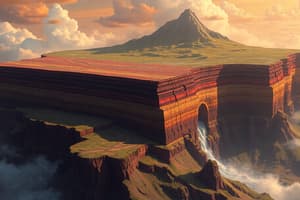Podcast
Questions and Answers
What type of plate boundary occurs when plates slide past each other without significant vertical movement?
What type of plate boundary occurs when plates slide past each other without significant vertical movement?
- Transform boundary (correct)
- Divergent boundary
- Convergent boundary
- Subduction boundary
Which of the following statements about transform boundaries is true?
Which of the following statements about transform boundaries is true?
- Transform boundaries lack seismic activity.
- Examples include the Mid-Atlantic Ridge.
- They are characterized by the formation of new landmasses.
- Their forces lead to vertical movement of plates. (correct)
What geological feature is an example of a transform boundary off the coast of Canada?
What geological feature is an example of a transform boundary off the coast of Canada?
- San Andreas Fault (correct)
- Himalayan Mountain Range
- Andes Mountain Range
- Mid-Atlantic Ridge
How do transform boundaries affect the Earth's surface indirectly?
How do transform boundaries affect the Earth's surface indirectly?
Which type of plate boundary plays a role in shaping the planet's diverse topography along with divergent and convergent boundaries?
Which type of plate boundary plays a role in shaping the planet's diverse topography along with divergent and convergent boundaries?
What type of plate boundary occurs when tectonic plates move away from each other?
What type of plate boundary occurs when tectonic plates move away from each other?
What geological feature is formed when two plates collide and neither fully subducts at a convergent boundary?
What geological feature is formed when two plates collide and neither fully subducts at a convergent boundary?
At which type of plate boundary do plates slide past each other horizontally?
At which type of plate boundary do plates slide past each other horizontally?
Which process leads to the creation of new crust at divergent plate boundaries?
Which process leads to the creation of new crust at divergent plate boundaries?
What occurs at a convergent plate boundary where one plate moves beneath another?
What occurs at a convergent plate boundary where one plate moves beneath another?
Study Notes
Plate tectonics is a fundamental geological concept that explains how Earth's outer layer, the lithosphere, moves and deforms. This movement results from three types of plate boundaries: divergent, convergent, and transform. These boundaries play a crucial role in shaping our planet's terrain and natural features.

Divergent Boundaries
Divergent plate boundaries occur where tectonic plates move away from each other, creating new crust by magmatic processes such as volcanic eruptions. As the plates separate, they create gaps where molten rock rises up to fill the voids and cool into solid rock. Over time, these cooling areas become new landmasses. Examples of divergent boundaries include the mid-Atlantic Ridge and the East African Rift Valley.
Convergent Boundaries
Convergent plate boundaries happen where two plates collide. One plate moves beneath another, either subducting (entering the mantle) or being accreted (combining with another plate). When plates subduct, the resulting pressure causes the landforms to uplift, often forming mountain ranges. When two plates collide and neither fully subducts, a volcanic arc forms along the boundary, such as the Pacific Ring of Fire. Examples of convergent boundaries include the North American Plate and the Pacific Plate.
Transform Boundaries
Transform plate boundaries occur where plates slide past each other without significant vertical movement, causing horizontal forces. These forces lead to earthquakes and changing landscapes. Transform boundaries usually lack magmatic activity, so they don't create new landmasses directly. However, their seismic activity can indirectly shape terrain by shifting existing geological structures. Examples of transform boundaries include the San Andreas Fault in California and the Queen Charlotte Fracture Zone off the coast of Canada.
In summary, understanding plate boundaries and their effects on land formation is crucial for comprehending the complex dynamics of Earth's surface. Each type of boundary – divergent, convergent, and transform – plays a distinct role in shaping our planet's diverse topography.
Studying That Suits You
Use AI to generate personalized quizzes and flashcards to suit your learning preferences.
Description
Test your knowledge of plate tectonics and the three main types of plate boundaries: divergent, convergent, and transform. Learn about how these boundaries shape Earth's terrain through magmatic processes, subduction, uplift, volcanic arcs, earthquakes, and more.




